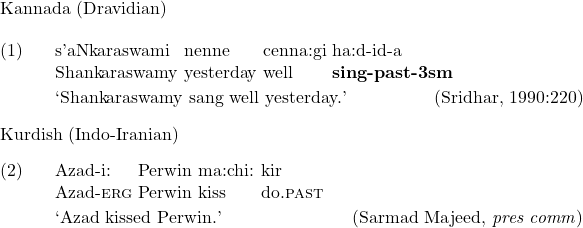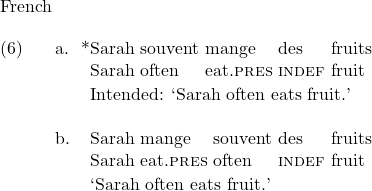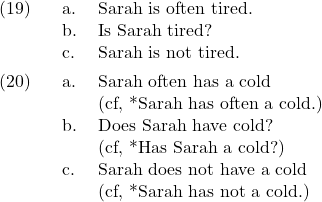7 Head-movement
Learning Objectives
By the end of this chapter, you should be able to,
- diagnose movement of T and V using adverb placement,
- represent movement of heads in trees
- recognize and represent do-support in English trees
Morphological Pieces in syntax
Before turning to the syntactic process of head-movement, we have to lay some groundwork. Consider a word like horses. English speakers will recognize that this word is made up of two pieces: the noun horse and the plural suffix -s.
We call each piece of a word a morpheme. Morphemes are the smallest units of sound-meaning correspondence. The morpheme horse cannot be divided up into any smaller unit. Hor doesn’t mean anything; orse doesn’t mean anything. Similarly, there’s no way to further sub-divide the suffix -s into anything smaller.
Morphology is the study of word-formation. What are the (perhaps language-specific) rules for putting morphemes together to form words? How do languages “build words?” There is a long debate about “where” word-building happens. Many scholars think that there is an independent, autonomous part of the grammar that governs how words are built. Once you’ve built a word, you can put it into your syntactic representation.
On the other hand, many scholars believe that word building is just another component of syntax. You don’t build words before you put them into the structure, you build words in the tree. Why would people think this? Well, one pretty strong piece of evidence that syntax and morphology are intrinsically connected is that morphology often reflects syntactic properties. For instance, as we will discuss at length below, Tense information is very often found bundled together with the verb; in English, the past tense walked contains two morphemes, walk and -ed. We know though that English also has a Tense Phrase. In the sentence Tamisha walked to the store, the head T will bear the feature [past] but that information is realized (i.e., pronounced) as the suffix -ed on the verb. Thus, there is, at least at some level, a correspondence between the head T and the head V.
For researchers that believe that word-building is done in the syntax, the feature [past] in English is pronounced (at least sometimes) as -ed. And moreover, there must be a way to get T and V together—that is, there must be a way to move either T or V—so that they form a word. This is the view that we will adopt.
Unfortunately, in this class we cannot delve deeply into the very interesting (and surprisingly contentious) debate concerning how words are built. If you’re interested, I recommend taking LING 527.
Tense Morphology
Let’s revisit an issue we put aside from chapter 5. There, we noted that, even though there is evidence for a Tense Phrase, sometimes, the expression of Tense is as part of the verb. In Swahili, we noted that tense is a verbal prefix.
| Past tense | /li-/ | a-li-anguka, ‘she/he fell’ |
| Present tense | /na-/ | a-na-anguka, ‘she/he falls’ |
| Future tense | /ta-/ | a-ta-anguka, ‘she/he will fall’ |
Marking tense on the verb is robustly attested across languages.

As we noted above, if T and V are syntactically introduced in different locations, then there must be a way to move one to the other so that they’re pronounced as a single word. Using an English example, suppose that the expression of past tense (the feature [past]) in English is -ed. Then it appears under the head T, and the verb walk appears under the head V.

So do we move V up to T? Or do we move T down to V? It turns out that languages make different choices. We can diagnose the difference by using adverb placement. Consider first the fact that some adverbs can be placed in-between T and V:
![]()
(4) tells us that that when T and V are separate words, then an adverb can be placed between them. This must correspond to VP-adjunction on the left.

We can use this information—the fact that some adverbs can left-adjoin to VP to diagnose how T and V get together. In English, we find that when T is a suffix, the V+T word appears to the right of the adverb.
![]()
This tells us that T must move down to the V. Otherwise, how would the T information (-ed) get on the other side of the adverb?
In contrast, compare what happens with adverb placement in French. Despite the fact that English and French are both canonical SVO languages, only English allows you to put adverbs in between the subject and the verb. In French, you have to put the adverb between the verb and object.

In French, the inflected verb appears to the left of the VP-adjoined adverb. It must therefore be the case that in French, the verb moves up to T.
This test allows us to infer movement. Given that we can independently diagnose the location of Tense by where will occurs, we can then consider what happens when we syntactically “separate” T and V. When T and V must form a word, where does that word appear with respect to the intervening material? It appears that some languages are Tense-lowering languages, and some languages are verb-raising languages.
Tense-Lowering and Verb-Raising
Again, the placement of the adverb tells us something about how V and T get together. In particular, because adverbs appear in front of the word V+T in English, we must conclude that T moves down to V in English. How else could we get the adverb in front of Tense?

In contrast, because adverbs appear after the verb in French, we must conclude that V moves up to T in French. Again, how else could we get the adverb to appear after the verb—-between the verb and object?

This kind of movement is called head-movement, because it involves movement of heads.
In these trees, we can represent movement with arrows. The arrows in the trees have no theoretical significance. They are purely so that we can read the trees easier. It is perfectly acceptable to write the trees without the arrows. This is because the traces in the trees tell you what has moved, and where. In the English tree, I can see that the head T is not present in TP in the tree above, instead the trace tT is there. The head T can be found in VP. Likewise, when V raises in French, the trace tV takes the place of the head of VP. Traces are theoretically significant. They are absolutely crucial in our representations. If we left out traces, then there would be no head of TP or VP when T or V moved away.
Keep in mind that T-lowering and V-raising are “necessity” movements. The problem with leaving T in TP in a past tense sentence in English is that the feature [past] simply isn’t a word on its own. It’s a morpheme that can only be pronounced when it’s attached to another word. So [past] must move somewhere, because it isn’t possible to pronounce it on its own.
The problem of getting T and V together goes away when T is just a word, not an affix. Thus, in English, future tense is expressed with the word will. There is no movement of T to V, and hence the adverb is pronounced in between the two, precisely where we expect it to be!

In contrast, in French, future tense is still a suffix, and V still raises to T, as the adverb placement tells us.

Key Takeaways
- To create morphologically complex words from syntactic heads, movement must take place.
- In English T lowers to V; in French V raises to T
Note that the English way of doing things is much rarer cross-linguistically than the French way. As a rule, when V and T form a word together, it’s because V raises to T. English is exceptional in this regard.
Tense-to-Complementizer movement
Another clear instance of head-movement occurs in questions in English.

Again, to get this word order, something needs to move, because normally the subject appears in front of T. In this case, T moves to the “question C,” represented as Cques.

This sort of movement is called T-to-C movement, or descriptively, “subject-auxiliary inversion.” This sort of movement is also head-movement because it again seems to only affect words, not phrases. The head T displaces to a pre-sentential position. T-to-C movement can also be thought of as a “necessity” movement. We can frame this as saying that Cques is an affix that needs to form a word with something. In English, it does so by “pulling” T to itself, like T does to V in French.
Head-movement (length: 1m 12s)
Do-support
In English, things get tricky when there are conflicting requirements. For instance, we saw that T can lower to V, and it can also raise to C. So what happens when those two movements come into conflict? What happens when there’s a question, but T doesn’t contain a full word, only a feature like [pres]? Let us consider the following example.
![]()
Something very particular happens here: in English, we insert a vacuous element do. What does do mean in this sentence? Nothing. Sarah isn’t “doing eating.” (For instance, we get the same do with non-action verbs: Does Sarah own a house?) Do is only there to fix a problem, namely, there is no way to pronounce the string of morphemes created when T moves to C. Crucially, C doesn’t have a phonological form, and T is just a feature [pres], or at best a suffix, -s, that can only be realized on another word (as we have seen with T-to-V movement in English).

Because do doesn’t mean anything, we will assume that it is merely a “trick” of phonology, or more specifically, it is a repair strategy. It repairs something that would be ineffable (meaning “can’t be said”). When do-support is needed, we will therefore leave it out of the tree.
There’s another place where do-support applies in English: negation.

Just like the adverb often, the negative element not appears between T and V:
![]()
But unlike adverbs, not appears to block T lowering to V. So just like when T moves to C, a feature like [pres] cannot be pronounced without some “help.” We insert do to repair the situation. Again, we will not represent the word do in our tree, because we are assuming that do-support is a “post-syntactic” operation; it happens after syntax.

But why does an intervening Neg head block T to V lowering? This is explained by appealing to a general constraint on head-movement called, fittingly, the Head-Movement Constraint or HMC. Below is the “informal” version of this constraint. We’ll be able to state a “formal” version once we have covered c-command (introduced in chapter 9).
Head movement cannot “skip over” heads.
Auxiliaries
English head-movement is particularly complex. We’ve seen above that, when necessary and possible, T lowers to V. This is an over-simplification. There are two instances where V raises to T in English: the auxiliary verbs BE and HAVE. Consider what happens when the auxiliaries are present in a question.

With auxiliary verbs, do-support doesn’t apply. This makes sense since we’ve been treating auxiliary verbs like is and have as T-elements. So in a question, we expect that they’ll move to C. However, BE and HAVE are clearly verbs—they are of category V. They bear all the morphological indicators of verbs (inflect for person, number, and tense) and they distribute like verbs (appear in places where verbs appear). We therefore conclude that sentences with auxiliary verbs have two distinct VPs. One VP is headed by the main verb, eaten, and the other is headed by the auxiliary. We moreover conclude that auxiliary verbs raise to T.


This directly predicts that auxiliaries should appear in front of adverbs like often.
![]()
One of the trickiest problems with English is the fact that auxiliary verbs appear to be able to ignore the head-movement constraint. V-to-T movement is not blocked in the presence of negation.
![]()
I know of no (good) explanation for why the HMC doesn’t apply here. But that doesn’t mean that the HMC isn’t a valid generalization. Its effects are robustly attested across languages.
Non-auxiliary be and have
As we just saw, auxiliary be and have move to T. What about when be and have are the only verbs in the sentence?
![]()
Does V still move to T in these sentences? Or, because they’re main verbs, maybe T moves to V. This is an empirical question, meaning that we simply have to look at the relevant data. That data is adverb placement, questions, and negation.

Looking at the data, we see that be as a main verb patterns just like be as an auxiliary. An adverb can come between be and its complement (AdjP), be raises to C in questions, and be appears in front of not in negative sentences. This behavior makes sense if be always raises to T, whether it’s an auxiliary or not.
In contrast, when have is used as a main verb, its behavior is different from have as an auxiliary. Adverbs must appear in front of have, and do-support applies in questions and negative sentences. This behavior makes sense if, with non-auxiliary have, T lowers to V. That is, main-verb have looks just like any other “real” verb, eat, walk, buy, smile, …


Summary of head-movement
- In most languages in which tense and the verb are pronounced as one word, V moves to T.
- In English,
- For main verbs (including have), T lowers to V, unless it’s blocked by negation or T moves to C.
- For auxiliary verbs, V raises to T in all cases.
- For main verb be, V raises to T in all cases.
The facts of English head-movement are particularly complicated. It is probably best if you just memorize these facts at the beginning. Keep in mind though that you can always reproduce the facts with the data above.
Where we’re going: Levels in Syntax
Drawing a tree with movement requires two steps.
- Draw the tree without movement first.
- Re-draw the tree with movement. Do not erase the first tree.
Thus, to draw the trees for the sentences we’ve been looking at, it is helpful to draw two distinct trees.


There are two “shortcuts” that you might try to do when first drawing trees, and they will invariably get you into trouble. The first shortcut is that you’ll want to draw just one tree, putting the movement in as you go. This is a bad way to do it, because sometimes—in fact, often—-there is more than one movement. For instance, questions that involve the verb be require movement of V to T, and then T to C. (See tree in above).
The second way you might get into trouble is if you start erasing. Here again, you’re bound to get confused once multiple movements start happening.
Actually, drawing two trees serves a theoretical purpose as well. Once we’ve introduced the idea of movement, we can think of our syntactic “object” as existing in levels. There’s one level which exists “pre-movement.” We call this level the Deep-Structure or D-structure for short. Then there’s the level after movement. We call this level the Surface-Structure, or S-structure for short. These levels have theoretical significance. Looking forward, we’ll find that certain constraints on syntax make reference only to the D-structure, while certain other constraints are sensitive to S-structure.
Advanced
Agglutination
English is a morphologically “poor” language: it tends to use separate words, rather than affixes, to express new meanings. But many languages are more expressive, allowing morphemes to “pile up” on words. The assumption we make is that each new morpheme on a word gets there through Head Movement. Thus, when we see a morphologically complex word with a lot of affixes, this word was “built” in the syntax by iterated instances of Head Movement.
Consider a morphologically complex word from the Bantu language Logoori.

The verb guduyekani consists of five different morphemes. There’s the root -duy- and then the affixes gu-, -ek, -an, and -i. In the view of syntax that we’re adopting in this class, each of these morphemes is added onto the root -duy as is makes its way up the tree. This is called agglutination. That is, each morpheme is the realization of a head in the tree which -duy– moves to. For instance, the suffix -an is an Event Pluralizer, and provides the meaning “repeatedly.” This head, call it EvPl, gets attached to -duy- when the verb moves to that phrase. The suffix -ek is an Anticausative, and detransitivizes the verb: the Patient becomes the subject. The prefix gu- and suffix -i are both considered functional morphemes. We typically assume that “Subject Marker” (SM), is associated with the head T, because subject marking in general varies with specifications of T. (For instance, in English, Spanish, French, etc, nonfinite verbs do not agree with subjects; only finite verbs do.) And we (that is, people who study Bantu languages), typically assume that the final vowel -i is associated with the head C.
The D-structure and S-structure trees are exemplified below. Note that we’re ignoring where the subject is for now.


By allowing the head –duy- to move up the tree, it can “collect” the heads along the way, creating the word in the syntax. Note, though, whether something ends up being a prefix or affix is not syntactic. The fact that gu- gets pronounced as a prefix and -i as a suffix is just an unpredictable property of these affixes.
The Mirror Principle
While Head Movement doesn’t determine what ends up being a prefix of suffix, it can determine the relative order of multiple prefixes and suffixes. For instance, in the trees above, I have placed the Anticausative head -ek lower in the tree than the Event Pluralizer -an. This is because in the word guduyekani, the suffix -ek is closer to root –duy-. Explicitly, the first head that -duy- moves to is -ek, so that gets attached to the root first. Then everything moves to -an, which will attach outside of -ek. Thus, the order of the morphemes mirrors the order of heads in the syntax.
Morphological order reflects syntactic order, and vice versa.
Intuitively, the Mirror Principle says that things that are lower in the tree are closer to the root, and vice versa: things that are closer to the root are lower in the tree.
The Mirror Principle is both widely adopted and widely questioned. On the one hand, it is extremely successful in explaining the relative ordering of morphemes in morphological complex words. On the other hand, there are many exceptions to the Mirror Principle, some of which defy good explanation. Putting the empirical picture aside, it is worth noting that this topic is heavily debated. Adopting the Mirror Principle, as we do in this class, forces us to assume a tight relationship between the fields of syntax and morphology. This is a controversial assumption. For more on this debate, and alternative views, consider taking LING 527/727.
- Baker, Mark (1985). "The mirror principle and morphosyntactic explanation". Linguistic Inquiry. 16: 373–415 Note that the Mirror Principle is often interpreted as a "rule" that languages have to follow. This is the wrong interpretation. The Mirror Principle is an observation about language. But there are certainly exceptions that appear to violate Mirror Principle orderings. ↵
A number category, indicating non-singular.
A morpheme is the smallest unit of sound-meaning correspondence. All words are made up of one or more morphemes.
Morphology is the study of morphemes. Morphemes are defined as the smallest unit of meaning.
SVO languages have the word order Subject-Verb-Object in positive declaratives.
Syntactically or semantically relevant information that is associated with a head.
A morpheme that attaches to the end of a word.
A c-commands B iff A's mother dominates B.
The progressive is an aspectual category that indicates an incomplete or ongoing action with respect to a particular event at a time. In English, progressive aspect is expressed using a finite form of the verb BE and the gerundive form of the verb, e.g., "John is eating sushi."
The perfect aspect is used to indicate an event which is completed by the indicated tense. Thus, in the "present perfect," the event of the verb has been completed by the present moment. In the "past perfect," the event of the verb has been completed at some past moment. In English, perfect is expressed using a finite form of the auxiliary verb HAVE and the participial form of the main verb, e.g., "John has eaten sushi."
Informally, the head-movement constraint says that heads cannot skip over intervening heads. Formally, the head-movement constraint says that a head can only move to the nearest c-commanding or c-commanded head.

